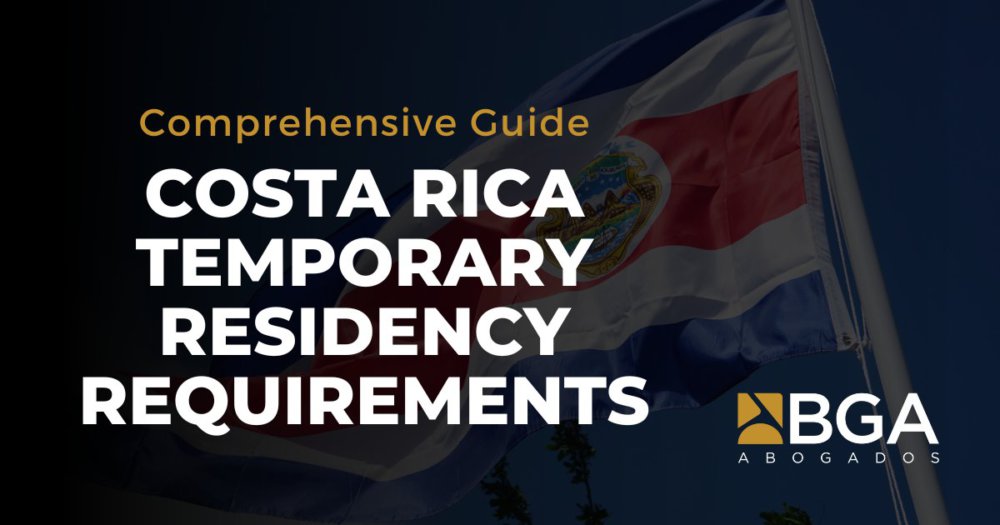Costa Rica temporary residency requirements are the starting point if you want to stay in the country beyond the usual tourist visa window. Many people come here on vacation and fall in love with the lifestyle. But turning that dream into a legal stay means learning what the government actually asks from you, preparing the paperwork correctly, and avoiding mistakes that could cost you months. That’s exactly where we step in at BGA Abogados.
Why temporary residency matters
Temporary residency gives you the legal right to live in Costa Rica for two years at a time. It’s renewable. And after three years, you may even apply for permanent residency. During that process, you get access to local services, healthcare, and the ability to open a bank account without constant tourist visa runs. For families, it creates stability. For professionals and investors, it gives credibility.
The main categories available
The law defines several residency options. Each has its own requirements, and your situation determines which path is right:
- Rentista residency: For those with guaranteed income of at least $2,500 USD per month. Usually backed by a bank guarantee. Learn more in detail here.
- Pensionado residency: For retirees receiving a lifetime pension of at least $1,000 USD per month.
- Inversionista residency: For individuals investing at least $150,000 USD in property or a business. We explain this option further in our page on Costa Rica residency by investment.
- Vínculo residency: For those married to or with children who are Costa Rican citizens.
- Digital nomad residency: A more recent option for remote workers earning $3,000+ USD monthly. If you work online, check the specific details here.
- Special categories: Missionaries, students, and certain professionals.
Core documentation required
Regardless of category, certain documents always show up on the list. These include:
- Birth certificate (recent, apostilled, and officially translated into Spanish).
- Police clearance from your home country (must show a clean record).
- Complete copy of your passport, every page certified.
- Proof of income or investment, depending on category.
- Marriage certificate if applying through a Costa Rican spouse.
- Consular registration form and fingerprint registration in Costa Rica.
It sounds straightforward, but the challenge is timing and presentation. Documents expire quickly, and translations must be exact. At BGA Abogados, we’ve seen too many applicants lose months simply because a single date or apostille was wrong.
Practical examples
Imagine you’re an American moving with your family. You choose the rentista route. You’ll need a Costa Rican bank account with a deposit of $60,000 USD, which proves the $2,500 monthly income. Once you show that, you get a two-year residency. Or take a digital nomad with steady online contracts. They simply provide proof of income and continue working for foreign companies while living in Costa Rica. That’s legal, and it avoids unnecessary headaches.
How long does it take?
On paper, approvals can take 12 to 15 months. With correct filing, we’ve seen approvals faster. With missing documents, delays easily stretch over two years. The truth? Success depends on how well you prepare and whether you have experienced lawyers handling your case.
Renewals and permanent residency
Temporary residency lasts two years. To renew, you need to prove you still meet the requirements. After three consecutive years, you may apply for permanent residency, which doesn’t expire. For example, U.S. citizens often take the rentista route first, and then move to permanent status. Learn more at Residency Costa Rica US Citizens.
Costs and government fees
The government charges application fees, security deposits, and translation costs. For a family of four, this can easily total several thousand dollars. What matters most is budgeting both time and money. We advise clients to treat this as an investment in stability and security, not just another administrative step.
Why work with us
At BGA Abogados, we bring over 27 years of national and international legal experience. Our predictive case analysis protocol, powered by artificial intelligence, helps us identify risks before they appear. That’s why our success rate is above 96% across more than 20 countries. When it comes to your future in Costa Rica, you want expertise on your side, not trial and error.
Taking the first step
If you’re serious about making Costa Rica your home, temporary residency is the foundation. We recommend starting early, gathering documents while they’re valid, and setting up a consultation with our team. You can reach us directly on WhatsApp. Acting before a conflict arises saves you months. We’ve seen it firsthand. You bring the vision, and we bring the structure. Together, we’ll make Costa Rica your legal home base.
Common mistakes to avoid
- Arriving with expired or non-apostilled documents.
- Trying to translate documents yourself instead of using an official translator.
- Not registering your fingerprints with the local Ministry of Security.
- Thinking temporary residency automatically gives you work rights (you need additional permits in some cases).
- Assuming the process is quick without legal guidance.
Living in Costa Rica with temporary residency
Once approved, you’ll get your DIMEX card (identification for foreign residents). With it, you can enroll in the Caja Costarricense de Seguro Social (the national health system), open bank accounts, and access local services. It’s the key to moving from “visitor” to “resident.” The peace of mind it brings is priceless.
Costa Rica temporary residency requirements
Whether you’re a retiree, a remote worker, or an investor, Costa Rica temporary residency requirements can be met with the right preparation. You don’t have to do it alone. Contact our team at BGA Abogados via WhatsApp, and we’ll guide you every step of the way. This is your chance to live in Costa Rica legally, safely, and without unnecessary stress. Costa Rica temporary residency requirements don’t have to be overwhelming when you have experts in your corner.
FAQs
What is the difference between temporary and permanent residency in Costa Rica?
Temporary residency lasts for two years and must be renewed. Permanent residency is granted after at least three years of holding temporary status and does not require renewal.
Can I work in Costa Rica with temporary residency?
Not automatically. Some categories, like inversionista or vínculo, may allow work. Others require additional permits. It’s important to confirm your category with a residency lawyer.
How much income do I need to qualify for rentista residency?
You must prove a guaranteed income of $2,500 USD per month, usually through a $60,000 USD bank deposit in Costa Rica.
How long does it take to process a temporary residency application?
Expect 12 to 15 months on average. With proper documentation and legal help, some cases move faster. Missing paperwork can double that timeline.
Can my family apply with me?
Yes. Spouses and dependent children under 25 can usually be included in your application. Each member must provide their own documentation.

